
The current In-Vitro Diagnostic (IVD) healthcare supply chain management practices and their impact on universal healthcare coverage: The case of County Referral Hospitals in Kenya
The use of in vitro diagnostics (IVDs) plays a crucial role in attaining the health-related objectives specified in the Sustainable Development Goals (SDGs) by 2030, particularly in low- and middle-income countries (LMICs). The topic of logistics and supply chain innovation in healthcare has gained considerable academic and practical interest.
In Kenya, the supply chain departments, commonly referred to as procurement departments, play a crucial role in achieving universal health coverage. The primary tasks of these departments involve acquiring high-quality in vitro diagnostics at reasonable prices and effectively transporting, storing, and distributing them to all health facilities, regardless of their geographical location within the county.
The characteristics and difficulties of a healthcare supply chain vary significantly depending on the country and are influenced by geographical, economic, and social factors. Due to economic and political considerations, the healthcare industry is currently receiving a great deal of focus. Moreover, the rise in healthcare expenditures has been attributed to a variety of factors, including, an aging population, increased healthcare service demand, rising prices for inpatient and outpatient treatment, and technological and pharmaceutical advancements (Economou et al., 2015).
The healthcare sector has recognized the significant role played by the supply chain departments in managing hospital costs and improving the flow of drugs from the supplier to the patient (Sahoo et al., 2022). As a result, there have been numerous studies conducted on efficiency, cost control, and optimization of material flow in this area.
The objective of this study was to analyze the current trends in the logistics for in-vitro diagnostic healthcare supply chains at county referral hospitals. This paper utilizes a framework for healthcare supply chain management systems to address three research questions.
Research questions
- What are the current healthcare supply chain management practices for in-vitro diagnostic supplies in county hospitals in Kenya?
- What are the main challenges county healthcare supply chains face when trying to implement universal healthcare Coverage?
- How do healthcare supply chain management practices impact universal healthcare coverage?
LITERATURE REVIEW
The Council of Supply Chain Operations developed the Supply Chain Operations Reference (SCOR) model, which provides a comprehensive framework that establishes a coherent structure by connecting performance measurements, processes, best practices, and individuals (Ntabe et al., 2015). Effective supply chain management, technology, and other initiatives are bolstered by the framework, which also fosters clear communication among supply chain stakeholders.
Companies use the Supply Chain Operations Reference Model to ensure that their supply chain is efficient and cost-effective. For businesses, the SCOR measurements provide a core framework against which to evaluate progress toward supply chain management objectives. The success of supply chain management (SCM) relies on the seamless integration of supply chain processes across the whole supply chain, from initial procurement to final delivery (Prasetyaningsih et al., 2020). The SCOR model delineates the essential business processes included in meeting consumer demand at each step of the process.
Figure I: Supply Chain Operations Reference (SCOR) Model
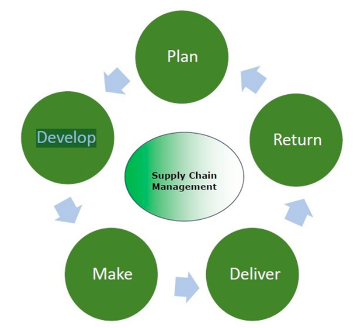
Source: Adapted from Supply Chain Council (2018)
The SCOR model is structured based on five primary components of business processes, namely Plan, develop, Make, Deliver, and return as outlined by Prasetyaningsih et al. (2020). Globally, the significance of SCOR for benchmarking, performance measurement, and business process re-engineering has been recognized for a very long time.
According to this model, in any organized supply chain process, the initial supply process is the planning stage. At this stage, the stakeholders develop metrics or product or service specifications to address how the products or services will satisfy the demands of the customers. The development stage, concentrates on building a strong relationship with the suppliers. This involves not only identifying dependable suppliers but also determining different planning methods for delivery and modes of payments. The third stage involves designing, developing, testing, and packaging customer’s products for delivery while the final stage is the return process whereby products that fail to meet the customers’ specifications are returned to the supplier.
Inventory Management Systems
Inventory management systems are specifically developed to effectively oversee and safeguard stockpiles (Saha and Ray (2019). This approach guarantees that an appropriate quantity of inventory is readily accessible when required and adheres to the requisite quality requirements. Inventory management systems are extensively used throughout a range of businesses, including manufacturing, utilities, healthcare, education, government, and other areas.
According to Damtew et al. (2019), the primary objective of a well-operating Inventory Management System in the healthcare system is to ensure that essential medications are readily available in sufficient quantities, appropriate dosage forms, and guaranteed quality, all at an affordable cost to the community that meets their needs. The absence of availability of in vitro diagnostics and other goods has been associated with a rise in illness and death rates for various diseases.
An effective health inventory management system guarantees that commodities are available promptly at all levels of the healthcare system. This helps prevent shortages and ensures commodity availability, ultimately meeting the needs of clients, patients, and customers.
Oballah et al. (2015) investigated the impact of inventory management practices on the performance of organizations in the public hospital context, specifically focusing on Kenyatta National Hospital. The research results showed that both inventory investment and inventory accuracy had a positive effect on the overall performance of an organization. Furthermore, the results indicated that inventory shrinkage had a negative effect that could be reduced by enhancing inventory accuracy. Two years later, Akinyi (2017) studied the effect of supply chain management procedures on the productivity of Kenya’s private hospitals. Customer relationship management, lean management, information sharing, ICT, strategic alliances, and outsourcing were all shown to positively affect the performance of private hospitals in Kenya.
Methodology
The present study used an exploratory research strategy. The study was centred on senior procurement officials employed at level IV county referral hospitals in Kenya. Semi-structured questionnaires were developed to assist in the collection of data. The questionnaires were developed after a thorough analysis of empirical and theoretical literature about in-vitro diagnostics supply chain management techniques at county referral hospitals. The choice of a semi-structured questionnaire was made due to its advantages in terms of participant engagement and data analysis. The questionnaires were sent to the participants during June and August in the year 2023. The acquired data was analyzed using descriptive statistics, including means, frequencies, and percentages, to fulfil the objectives and goals of this research.
The present study used an exploratory research strategy. The study was centered on senior procurement officials employed at level IV county referral hospitals in Kenya. Semi-structured questionnaires were developed to assist in the collection of data. The questionnaires were developed after a thorough analysis of empirical and theoretical literature about in-vitro diagnostics supply chain management techniques at the county
RESULTS
Years worked as a procurement officer in this hospitalThe respondents were asked to indicate the number of years they have worked as procurement officers in their particular hospitals.
Their responses are shown in Table 1

The findings indicate that the majority of procurement officers (48.94%) have worked within the 6-10-year range.
The implication for this is that there is a relatively seasoned workforce that possesses a deep understanding of the procurement processes and challenges specific to their hospital.
Level of education
The researcher conducted an assessment of the educational background of the respondents. Consequently, the participants were requested to specify their level of educational attainment. The participants’ answers are presented in Table 2.
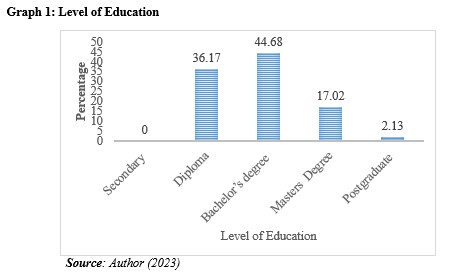
Findings show that all the respondents were qualified to be procurement officers and hence able to evaluate the supply chain management practices. The majority of procurement officers (44.68%) possess a bachelor’s degree, indicating a relatively well-educated workforce that could potentially bring a solid theoretical foundation to their roles
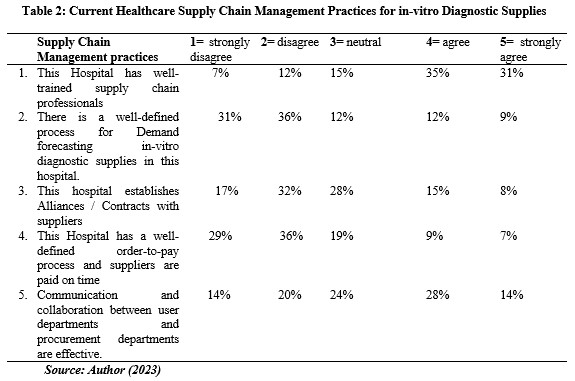
From the study findings, the highest proportion of respondents (66%) conveys agreement that the county referral hospitals have a sufficient pool of well-trained supply chain professionals. However, 31% strongly disagree and 36% disagree that their hospitals have a well-defined process for demand forecasting in-vitro diagnostic supplies.
Demand forecasting for many health commodities is challenging as indicated by 67% of the respondents and this is a great setback to the achievement of universal healthcare coverage. The process of demand forecasting helps in predicting changes in demand and making informed choices to keep inventory levels at an optimal point. By doing so, costs can be minimized, and essential supplies can be readily available.
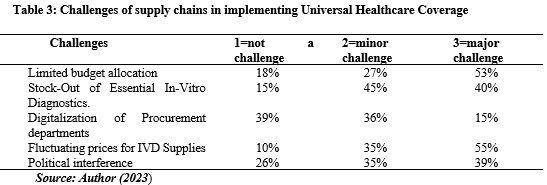
The limited budget allocation impacting the availability of vital in-vitro diagnostic supplies is a significant hurdle, identified as a major challenge by 53% of respondents. Only 18% believed budget allocations were sufficient. Insufficient distribution of funds may have a substantial influence on the accessibility of crucial medical resources including in-vitro diagnostics. Lack of funding may also limit the ability to invest in advanced inventory management technologies, digitalization of procurement processes, and staff training affecting the efficiency of supply chain operations.
In addition, 40% of respondents identify the shortage of essential in-vitro diagnostics as a significant obstacle to the implementation of universal health coverage. The availability of diagnostics influences patient confidence in healthcare providers positively (August Kuwawenaruwa, 2020), whereas medication stock-outs in facilities nurture mistrust in healthcare providers and contribute to the low implementation of universal health coverage.
A majority of individuals, specifically 64%, believe that political intervention in the management of supply chains for in vitro diagnostics (IVD) is hurting the successful implementation of universal health coverage. The study reveals that when political interference occurs in the process of awarding contracts for IVD supplies, it has a detrimental impact on the overall performance in terms of cost and quality.
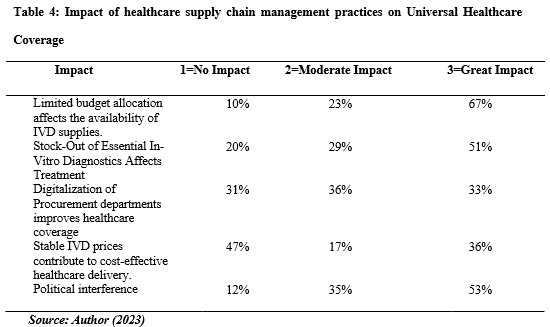
From the study findings, the highest percentage of respondents indicates that limited budget allocation affects the availability of essential medical supplies with 67% acknowledging this positive influence. Equally noteworthy is the finding that stock out of essential IVD supplies substantially enhances equitable access to healthcare services, highlighted by 51% of respondents.
CONCLUSIONS AND RECOMMENDATIONS
This study investigates the current healthcare supply chain management practices for county hospitals’ in-vitro diagnostic (IVD) supplies. It also explores the challenges faced by county healthcare supply chain officers in implementing universal healthcare coverage. Further, the research analyzes the impact of the current healthcare supply chain management practices on the achievement of universal healthcare in Kenya.
The study’s results show that the respondents generally agree that the county referral hospitals employ qualified supply chain management professionals who are responsible for managing procurement and inventory management for in vitro diagnostics. However, there were concerns by over 66% of the respondents about the lack of well-defined demand forecasting processes leading to gross stock-out of essential in-vitro diagnostics.
The findings further indicate that the majority of the respondents believe their hospitals don’t have a well-defined order-to-pay process and suppliers are not paid in good time. As a result, suppliers withhold supplies to hospitals leading to frequent stock-outs and hence affecting the actualization of universal health care coverage.
Moreover, the research revealed that county healthcare supply chains face several other challenges including limited budget allocation, fluctuating prices due to dollar volatility, and political interference in the procurement process. The participants recognize the positive impact of increased budget allocation to county healthcare departments to ensure and promote equal access to healthcare.
The study recommends an increase in budget allocation to avoid stock-outs, improve demand forecasting techniques, sign and honor supply contracts with suppliers, and put measures in place to bar politicians from infiltrating procurement processes.
References
Ahmadi, E., Mosadegh, H., Maihami, R., Ghalehkhondabi, I., Sun, M., & Süer, G. A. (2022). Intelligent inventory management approaches for perishable pharmaceutical products in a healthcare supply chain. Computers & Operations Research, 147, 105968.
Akenroye, T. O., Oyedijo, A., Rajan, V. C., Zsidisin, G. A., Mkansi, M., & Baz, J. E. (2023). Connecting the dots: uncovering the relationships between challenges confronting Africa’s organ transplant supply chain systems. Supply Chain Management: An International Journal, 28(7), 43-61.
Akinyi, O. (2017). Supply Chain Management Practices and Performance of Private Hospitals in Nairobi, Kenya.
Al-Saa’da, R. J., Taleb, Y. K. A., Al Abdallat, M. E., Al-Mahasneh, R. A. A., Nimer, N. A., & Al-Weshah, G. A. (2013). Supply chain management and its effect on health care service quality: quantitative evidence from Jordanian private hospitals. Journal of Management and Strategy, 4(2), 42.
Anita Musiega, E. a. (2022). Examining the influence of budget execution processes on the efficiency of county health systems in Kenya. Health Policy and Planning, Oxford, 351-362.
August Kuwawenaruwa, K. W. (2020). The effects of medicines availability and stock-outs on household’s utilization of healthcare services in Dodoma region, Tanzania. Oxford Health Policy and Planning, 323-334.
Beaulieu, M., & Bentahar, O. (2021). Digitalization of the healthcare supply chain: A roadmap to generate benefits and effectively support healthcare delivery. Technological forecasting and social change, 167, 120717.
Binyaruka, P., & Borghi, J. (2017). Improving the quality of care through payment for performance: examining effects on the availability and stock‐out of essential medical commodities in Tanzania. Tropical Medicine & International Health, 22(1), 92-102.
Bossert, T. J., Bowser, D. M., & Amenyah, J. K. (2007). Is decentralization good for logistics systems? Evidence on essential medicine logistics in Ghana and Guatemala. Health Policy and Planning, 22(2), 73-82.
Carrus, P. I. E. R., Marras, F., & Pinna, R. (2015). The drug logistics process: an innovation experience. The TQM Journal, 27(2), 214-230.
Damtew, D., Worku, F., Tesfaye, Y., & Jemal, A. (2019). Availability of lifesaving maternal and child health commodities and associated factors in public and private health facilities of Addis Ababa, Ethiopia. Health services research and managerial epidemiology, 6, 2333392819892350.
Dasaklis, T., & Casino, F. (2019, May). Improving vendor-managed inventory strategy based on Internet of Things (IoT) applications and blockchain technology. In 2019 IEEE International Conference on Blockchain and Cryptocurrency (ICBC) (pp. 50-55). IEEE.
Economou, C., Kaitelidou, D., Kentikelenis, A., Maresso, A., & Sissouras, A. (2015). The impact of the crisis on the health system and health in Greece. In Economic crisis, health systems and health in Europe: Country experience [Internet]. European Observatory on Health Systems and Policies.
Gubala, V., Harris, L. F., Ricco, A. J., Tan, M. X., & Williams, D. E. (2012). Point of care diagnostics: status and future. Analytical chemistry, 84(2), 487-515.
Hallas, L. (2019). Cost, Capacity, and Care: History and Implementation Considerations of the WHO’s Essential Diagnostics List. Plan II Honors Theses-Openly Available.
Hamadneh, S., Pedersen, O., Alshurideh, M., Al Kurdi, B., & Alzoubi, H. M. (2021). An investigation of the role of supply chain visibility into the scottish blood supply chain. J. Legal Ethical & Regul. Isses, 24, 1.
Hassan, A. M. (2012). Supply Chain Management Practices Among Humanitarian Organisations in Kenya. Unpublished
Jæger, B., Menebo, M. M., & Upadhyay, A. (2021). Identification of environmental supply chain bottlenecks: a case study of the Ethiopian healthcare supply chain. Management of Environmental Quality: An International Journal, 32(6), 1233-1254.
Joseph Oindo, E. O. (2021). How African Kinship System Contributes to Corruption in Kenya. Scientific Research Publishing, 21-38.
Kahiri, J., Arasa, R., Ngugi, P., & Njeru, S. E. (2015). Procurement Policies and implementation of Effective Procurement Practices in tertiary Public Training Institutions in Kenya (Doctoral dissertation, Master’s thesis, Kenyatta University]. https://irlibrary. ku. ac. ke/handle/123456789/12263).
Kavanagh, K. T., Saman, D. M., Bartel, R., & Westerman, K. (2017). Estimating hospital-related deaths due to medical error. Journal of Patient Safety, 13(1), 1-5.
Kheirkhah, A., Satitpitakul, V., Syed, Z. A., Müller, R., Goyal, S., Tu, E. Y., & Dana, R. (2018). Factors influencing the diagnostic accuracy of laser-scanning in vivo confocal microscopy for Acanthamoeba keratitis. Cornea, 37(7), 818-823.
Kihara, B. W., & Ngugi, P. K. (2021). Inventory management systems and performance of public hospitals in Kenya; case of counties under universal Health care programme. International Journal of Social Sciences and Information Technology, 7(2), 66-77.
Kiragu, Z. W., Rockers, P. C., Onyango, M. A., Mungai, J., Mboya, J., Laing, R., & Wirtz, V. J. (2022). Household access to non-communicable disease medicines during universal health care roll-out in Kenya: A time series analysis. PLoS One, 17(4), e0266715.
Kirui, E. K., & Maina, K. E. (2018). Effect of optimization practices on operational performance of construction industry in Uasin Gishu County, Kenya. International Academic Journal of Economics and Finance, 3(2), 309-322.
Kuupiel, D., Bawontuo, V., Donkoh, A., Drain, P. K., & Mashamba-Thompson, T. P. (2019). Empirical framework for point-of-care diagnostics supply chain Management for Accessibility and Sustainability of diagnostic Services in Ghana’s primary Health care clinics. Point of Care, 18(2), 72-75.
Lee, D., & Yoon, S. N. (2021). Application of artificial intelligence-based technologies in the healthcare industry: Opportunities and challenges. International Journal of Environmental Research and Public Health, 18(1), 271.
Maina, C., Njehia, B. K., & Eric, B. K. (2020). Sources Of Competitive Advantage in the Dairy Industry: Supply Chain Management Practices. International Journal of Supply Chain Management, 5(1), 54-72.
Marimuthu, S. S., Kuppusamy, G., Radhakrishnan, A., Saravanan, J., & Thirugnanasambandham, I. (2022). Current regulatory landscape on fast-track pathway for IVDs under COVID-19 health emergency in India. Journal of Applied Pharmaceutical Science, 12(7), 078-087.
Mathew, J., John, J., & Kumar, S. (2013, May). New trends in healthcare supply chain. In annals of POMS conference proceedings; Denver (pp. 1-10).
Mohammed, F. (2021). AN ASSESSMENT OF INVENTORY MANAGEMENT SYSTEM THE CASE OF HABESHA CEMENT SHARE COMPANY (Doctoral dissertation, ST. MARY’S UNIVERSITY).
Muchaendepi, W., Mbohwa, C., Hamandishe, T., & Kanyepe, J. (2019). Inventory management and performance of SMEs in the manufacturing sector of Harare. Procedia Manufacturing, 33, 454-461.
Nduta Kamere, V. R. (2021). Supply Chain Factors and Antimicrobial Stewardship. Bulletin of the World Health Organization, Article ID: BLT.22.288650, 1-17.
Nelson Keyonzo, P. N. (2015). Tupange’s Experience with Scaling Up Family Planning Interventions in Urban Kenya. Reproductive Health Matters, 1-11.
Ntabe, E. N., LeBel, L., Munson, A. D., & Santa-Eulalia, L. A. (2015). A systematic literature review of the supply chain operations reference (SCOR) model application with special attention to environmental issues. International Journal of Production Economics, 169, 310-332.
Oballah, D., Waiganjo, E., & Wachiuri, W. E. (2015). Effect of inventory management practices on Organizational performance in Public health institutions in Kenya: A case study of Kenyatta national hospital. International journal of education and research, 3(3), 703-714.
Odhiambo, P. O. (2014). Supply chain management practices and service quality among public hospitals in Nairobi county, Kenya (Doctoral dissertation, University of Nairobi).
Oladele, T. O., Ogundokun, R. O., Adegun, A. A., Adeniyi, E. A., & Ajanaku, A. T. (2021). Development of an inventory management system using association rule. Indonesian Journal of Electrical Engineering and Computer Science, 21(3), 1868-1876.
Patel, A., D’Alessandro, M. M., Ireland, K. J., Burel, W. G., Wencil, E. B., & Rasmussen, S. A. (2017). Personal protective equipment supply chain: lessons learned from recent public health emergency responses. Health security, 15(3), 244-252.
Pinna, R., Carrus, P. P., & Marras, F. (2015). Emerging trends in healthcare supply chain management—an Italian experience. Applications of contemporary management approaches in supply chains, 117-137.
Plebani, M. (2015). Clinical laboratories: production industry or medical services?. Clinical Chemistry and Laboratory Medicine (CCLM), 53(7), 995-1004.
Prasetyaningsih, E., Muhamad, C. R., & Amolina, S. (2020, April). Assessing of supply chain performance by adopting Supply Chain Operation Reference (SCOR) model. In IOP Conference Series: Materials Science and Engineering (Vol. 830, No. 3, p. 032083). IOP Publishing.
R.H.Thilakarathna, M. T. (2017). The Supply Chain Operations Reference (SCOR) model: A Systematic Review of Literature from the Apparel Industry. International Conference on Business Management (pp. 1-26). Colombo: Researchgate.
Regin, R., Rajest, S. S., & Shynu, T. (2022). Pharmaceutical Supply Chain Challenges and Inventory Management. Central Asian Journal of Innovations on Tourism Management and Finance, 3(10), 143-159.
Roberton, T., Carter, E. D., Chou, V. B., Stegmuller, A. R., Jackson, B. D., Tam, Y., … & Walker, N. (2020). Early estimates of the indirect effects of the COVID-19 pandemic on maternal and child mortality in low-income and middle-income countries: a modelling study. The Lancet global health, 8(7), e901-e908.
Saha, E., & Ray, P. K. (2019). Modelling and analysis of inventory management systems in healthcare: A review and reflections. Computers & Industrial Engineering, 137, 106051.
Sahoo, S., Kumar, S., Sivarajah, U., Lim, W. M., Westland, J. C., & Kumar, A. (2022). Blockchain for sustainable supply chain management: trends and ways forward. Electronic Commerce Research, 1-56.
Shajema, I. I. (2018). Effect of inventory control practices on performance of retail chain stores in Nairobi County, Kenya. Journal of International Business, Innovation and Strategic Management, 2(1), 18-38.
Shradha Ashok Gawankar, S. K., & Rakesh Raut. (2017). Article information : An International Journal, 24(1), 257–295. https://doi.org/10.1108/BIJ-12-2015-0123
Sundram, K., Ibrahim, A. R., & Govindaraju, V. G. R. C. (2011). Supply chain management practices in the electronics industry in Malaysia: Consequences for supply chain performance. Benchmarking, 18(6), 834–855.https://doi.org/10.1108/14635771111180725
Thorpe, A. A., Bach, F. C., Tryfonidou, M. A., Le Maitre, C. L., Mwale, F., Diwan, A. D., & Ito, K. (2018). Leaping the hurdles in developing regenerative treatments for the intervertebral disc from preclinical to clinical. JOR spine, 1(3), e1027.
Weyers, M. (2017). An application of the supply chain operations reference model for the service supply chain for standardised back office services (Doctoral dissertation, Stellenbosch: Stellenbosch University).
Wilson, M. L., Fleming, K. A., Kuti, M. A., Looi, L. M., Lago, N., & Ru, K. (2018). Access to pathology and laboratory medicine services: a crucial gap. The Lancet, 391(10133), 1927-1938.
World Health Organization, & World Bank. (2021). Tracking universal health coverage: 2021 Global monitoring report.
World Health Organization. (2017). Guidance for procurement of in vitro diagnostics and related laboratory items.
Author: Josephat Sua, student LIGS University
Approved by: Zdeno Matta, lecturer LIGS University



